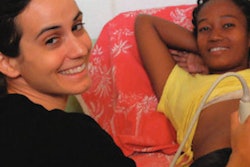
The developers of a new imaging device that combines digital x-ray and ultrasound in a low-cost system hope it will provide a much-needed boost for healthcare in the developing world. Project GlobalDiagnostix has been launched by EssentialMed to meet the needs of patients and healthcare professionals in resource-poor regions.
During his career in the medical device industry, the organization's CEO Dr. Klaus Schönenberger was dismayed at the discrepancy in geographical distribution of equipment sales: 93% were made in Europe, the U.S., and Japan, and two-thirds of the global population had no access to diagnostic imaging, he stated. In Laos' public health system, for example, only 19 analogue x-ray machines serve a population of almost 7 million people, and there is no digital x-ray in the country.
 Dr. Klaus Schönenberger and a repair technician from a large hospital in Cameroon discuss how the inability to procure a simple, cheap spare part prevents them from repairing medical equipment. All images courtesy of Dr. Schönenberger.
Dr. Klaus Schönenberger and a repair technician from a large hospital in Cameroon discuss how the inability to procure a simple, cheap spare part prevents them from repairing medical equipment. All images courtesy of Dr. Schönenberger.Determined to change this and with an optimal system in mind, Schönenberger collaborated with two other field experts and created what he calls "a nonprofit foundation with an industrial mindset": the EssentialMed Foundation. The foundation collaborates with the Swiss Federal Institute of Technology in Lausanne, the Paul Scherrer Institute, and the Swiss Tropical and Public Health Institute in Basel, Switzerland.
A longstanding concern of the World Health Organization (WHO) is that few donated devices deliver the medical function for which they are intended once they reach developing countries. It estimates that between 10% and 30% of the more complex devices even become inoperational upon delivery due to absence of cables, documentation in the right language, or lack of knowledge on how to install the equipment, according to Schönenberger. The real challenge therefore lies in the design that must be realized from scratch and tailored for the context in which it will be used.
 A typical district hospital in Cameroon, where radiography equipment is not available but is badly needed. Cameroon has about 180 hospitals of this type.
A typical district hospital in Cameroon, where radiography equipment is not available but is badly needed. Cameroon has about 180 hospitals of this type."Each screw must have an optimal cost-robustness ratio and the device must be genuinely profitable for its producers," he explained. "We are not coming to anyone with a begging cap. We have a solid business plan, and collaborations with companies could be mutually beneficial. After all, the device will be low-cost and is targeting a big, big market. It might also appeal to a company's CSR [corporate social responsibility] policy."
With input from WHO's former head of imaging, the late Dr. Harald Østensen, the team settled on the general specifications for a device, which will cover 80% of a district hospital's imaging needs and will initially be deployed in Cameroon, Mali, and Laos, where the prevalence of cellphones offers the potential to use mobile networks to transfer digital images. The team is at present concentrating on a call for design ideas that factor in a list of technical considerations. For example, given the usual moist, unclean environment and the transients in electrical supply, the C-arm should contain no electro-mechanical motor or components but must be able to move manually through innovative balanced mechanisms.
 A relatively new x-ray machine in a hospital in Cameroon, from which the cassette had been stolen. Due to the difficulties of buying a new one, the equipment has been idle ever since. This illustrates one of the many context-related difficulties to be considered in the design of an appropriate diagnostic imaging device.
A relatively new x-ray machine in a hospital in Cameroon, from which the cassette had been stolen. Due to the difficulties of buying a new one, the equipment has been idle ever since. This illustrates one of the many context-related difficulties to be considered in the design of an appropriate diagnostic imaging device.Because electricity is needed for the key functions such as x-ray tube, digital detector, and viewing screen, the system should include components to protect itself against instable electrical supply and will also need to include an extremely durable, ecologically acceptable, low-cost, and low-maintenance internal power storage capacity to allow continuous operation.
A shortfall of 3.3 million Swiss francs (2.9 million euros) exists in the research budget, and with many of EssentialMed's alliance of professors and laboratories financing their own participation, the project finds itself in a "soft-start," as the hunt continues for financial partners. However, it is hoped that after two-and-a-half years there will be a feasibility prototype to show and discuss with participating project partners in the pilot countries as a way of locally validating the design.
 Imaging equipment is rendered useless when the electrical infrastructure is obsolete and dysfunctional, as in this case.
Imaging equipment is rendered useless when the electrical infrastructure is obsolete and dysfunctional, as in this case."The real quantum leap must be in terms of price," Schönenberger said. "In our opinion the total cost of ownership [TCO], including capital purchase and cost incurred during the whole life cycle of the product such as training, maintenance, repair, and consumables, should be achieved at a maximum of 10% of the usual TCO of such a product. I know it sounds unreasonable but we are unreasonable!"



















